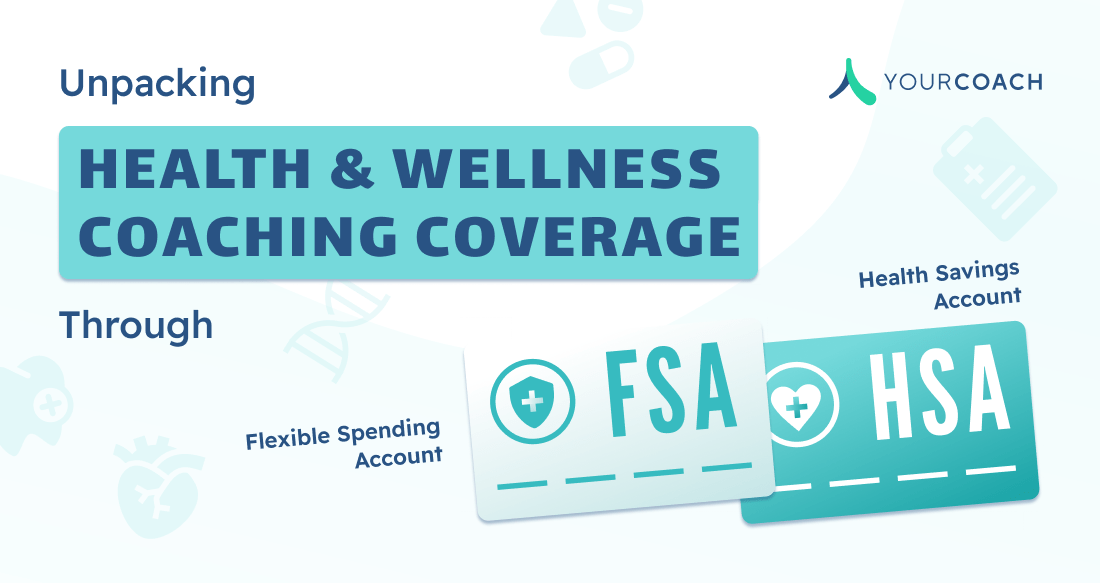
In mid-July, the National Board of Certified Health & Wellness Coaching (NBHWC) issued an update on utilizing Health Savings Accounts (HSA) and Flexible Spending Accounts (FSA) towards health coaching. Though it’s not explicitly included in the current IRS guidelines, they’ve shared with the NBHWC that “out-of-pocket costs of health and wellness coaching services can be a ‘qualified medical expense’ if the services are provided for the treatment or prevention of a disease.”
Firstly, this news exemplifies the widespread recognition health coaching is receiving across industries. It’s systematically becoming accepted as a core tool towards achieving optimal health and wellbeing. Many of our Industry Partners and validated coaches, alike, have already asked—so what does this mean in practice?
Especially as we look ahead to open enrollment in the fall, this is an important time for every health and care company to understand the implications of this news. Today, we begin to unpack what this means for health coaching and beyond both now and in the future.
What are HSA/FSA accounts?
HSAs and FSAs are accounts that allow individuals to put pre-tax dollars aside for use towards qualified, health-related expenses. They can be helpful for those looking to plan ahead for the unknown while also encouraging them to take an active role in investing in and managing their health.
HSAs are typically tied to high-deductible health plans (a plan that typically has a higher deductible than most other plans) and are managed by the individual. These funds can roll over from year to year and can be invested when not in use. FSAs are employer-managed accounts. They’re non-investable and all funds must be used within the plan year.
The IRS determines which expenses are eligible for HSAs and FSAs and lists them out in their Publication 502. This form has yet to be refreshed to include specifics around health coaching reimbursements (and it’s unclear how much they’ll outline of the specifics in the future), but we’ve compiled what we know through some investigating.
What do we know about reimbursements for health coaching?
According to the NBHWC and our research, out-of-pocket costs associated with health coaching might be reimbursable when used towards the treatment or prevention of a disease. When our team spoke with customer service representatives at one of the largest insurance providers in the US, we received similar guidance that coverage would likely be dictated by “medical necessity” as is standard with most FSA/HSA-eligible expenses
So what does this mean in practice? We were advised by one of the four largest FSA/HSA providers and the NBHWC that referrals from a physician or credentialed health care provider to the health coach would give individuals the best chance in having associated costs covered. In order to establish medical necessity, it’s important to work closely with the physician to help provide the right documentation to establish a case for coverage. These standards are ongoing and subject to change, but we plan to update our community as new information is available.
When will health coaching become covered by my insurance?
HSA/FSA eligibility is a huge first step towards the imminent—ensuring health coaching is covered by insurances across the US. Our team is closely involved in advocating for this change and committed to steadily updating our community as new information is available. Most recently, the Centers for Medicare and Medicaid published a proposed 2024 physical fee schedule which includes codes that cover health and wellbeing coaching, and the comments on the proposal are due early September.
Our team plans to be heavily involved in support of reimbursements for health coaching, in the hopes these critical services become reimbursable by most plans in the new year. It’s important to note that the standards for reimbursement have yet to be defined (ex. Will coverage only apply in cases of medical necessity, like HSA/FSA reimbursement; and will coaches need a clinical background in order to be covered).
We plan to keep a finger on the pulse of these conversations as they develop, while working closely with our existing and prospective Industry Partners to understand how this might expand access to our collaborative services.


